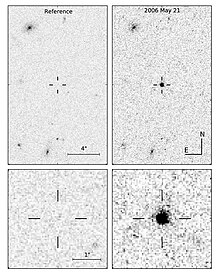SCP 06F6

The sudden appearance of the transient "mystery object" SCP 06F6 in Hubble Space Telescope's field of view. The lower image quadrant represents a zoomed in view.
|
|
| Other designations | SCP 06F6 |
|---|---|
| Event type |
Supernova |
| Constellation |
Boötes |
|
[]
|
|
Coordinates: ![]() 14h 32m 27.42s, +33° 32′ 25.1″
14h 32m 27.42s, +33° 32′ 25.1″
SCP 06F6 is (or was) an astronomical object of unknown type, discovered on 21 February 2006 in the constellation Boötes during a survey of galaxy cluster CL 1432.5+3332.8 with the Hubble Space Telescope's Advanced Camera for Surveys Wide Field Channel.
According to research authored by Kyle Barbary of the Supernova Cosmology Project, the object brightened over a period of roughly 100 days, reaching a peak intensity of magnitude 21; it then faded over a similar period.
Barbary and colleagues report that the spectrum of light emitted from the object does not match known supernova types, and is dissimilar to any known phenomenon in the Sloan Digital Sky Survey database. The light in the blue region shows broad line features, while the red region shows continuous emission. The spectrum shows a handful of spectral lines, but when astronomers try to trace any one of them to an element the other lines fail to match up with any other known elements.
Because of its uncommon spectrum, the team was not able to determine the distance to the object using standard redshift techniques; it is not even known whether the object is within or outside the Milky Way. Furthermore, no Milky Way star or external galaxy has been detected at this location, meaning any source is very faint.
...
Wikipedia
